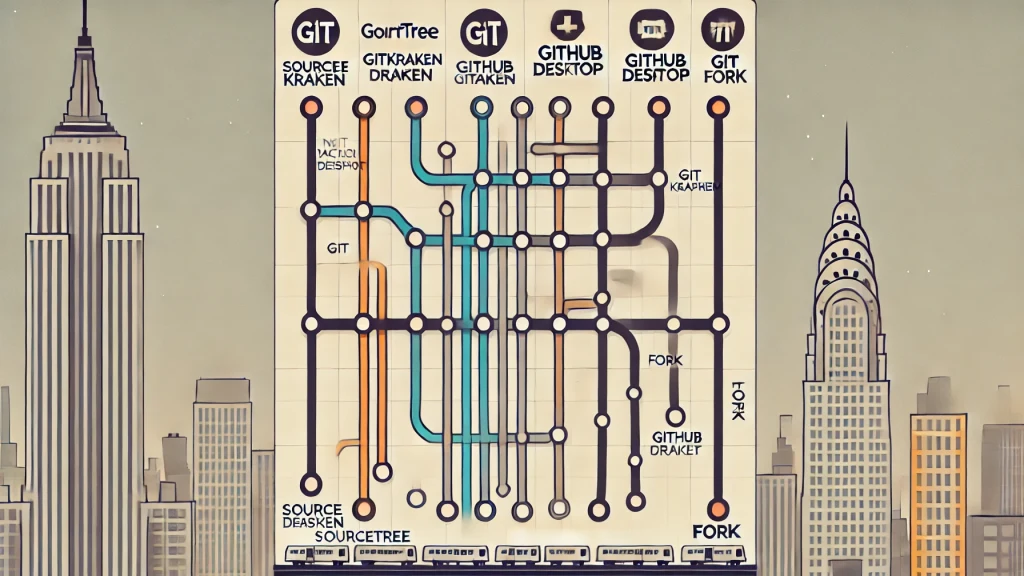Sourcetree, GitKraken, GitHub Desktop, and Fork: Top 4 UI Git Clients Compared
Git, the distributed version control system, is an essential tool for developers worldwide. While the command line is powerful, many developers prefer using graphical user interfaces (GUIs) for an intuitive and streamlined experience. Among the plethora of Git UI clients available, Sourcetree, GitKraken, GitHub Desktop, and Fork stand out as some of the most popular choices. In this post, we’ll compare these four top contenders, exploring their key features, strengths, and weaknesses.
Sourcetree: The Veteran GUI
Developed by: Atlassian
Platforms: Windows, macOS
Price: Free
Overview: Sourcetree is a veteran in the realm of Git GUIs, known for its robust feature set and comprehensive functionality. It's an excellent choice for both beginners and advanced users due to its user-friendly interface and support for complex Git operations.
Key Features:
- Visual Commit History: Sourcetree offers a clear and detailed graphical representation of your commit history, making it easy to track changes and understand the progression of your project.
- Branching and Merging: The tool simplifies the branching and merging process, with visual aids that help users manage these often complex tasks.
- Submodule Support: Sourcetree provides solid support for Git submodules, allowing users to manage multiple repositories within a single project.
Strengths:
- Free to Use: Sourcetree is completely free, making it accessible to all developers.
- Detailed Interface: Its detailed interface helps users grasp the intricacies of Git operations.
Weaknesses:
- Performance Issues: Some users report that Sourcetree can be slow, especially with large repositories.
- Steeper Learning Curve: While feature-rich, the interface can be overwhelming for absolute beginners.
GitKraken: The Modern Powerhouse
Developed by: Axosoft
Platforms: Windows, macOS, Linux
Price: Free (Basic), Paid (Pro & Enterprise)
Overview: GitKraken is known for its visually appealing and intuitive interface. It combines powerful Git features with a modern design, making it a favorite among many developers.
Key Features:
- Cross-Platform Support: Unlike some other Git clients, GitKraken is available on Windows, macOS, and Linux.
- Built-in Gitflow: GitKraken provides built-in Gitflow support, making it easier for teams to follow a structured branching model.
- Merge Conflict Resolution: The tool includes a visual merge conflict editor, simplifying the often tricky task of resolving conflicts.
Strengths:
- User-Friendly Interface: GitKraken’s interface is sleek and modern, making it accessible and enjoyable to use.
- Powerful Features: It offers advanced features like in-app code editing and integrations with other development tools.
Weaknesses:
- Cost: While the basic version is free, advanced features require a paid subscription.
- Resource-Intensive: GitKraken can be resource-heavy, which may impact performance on less powerful machines.
GitHub Desktop: Seamless GitHub Integration
Developed by: GitHub
Platforms: Windows, macOS
Price: Free
Overview: GitHub Desktop is a Git client developed by GitHub, offering seamless integration with GitHub repositories. It is designed to make Git more approachable for newcomers, with a straightforward and minimalistic interface.
Key Features:
- Simple Interface: The clean and minimalistic design makes it easy to perform basic Git operations without feeling overwhelmed.
- GitHub Integration: As expected, GitHub Desktop integrates seamlessly with GitHub, allowing users to clone repositories, create branches, and issue pull requests with ease.
- User-Friendly Workflow: The tool simplifies the Git workflow, making it an excellent choice for those new to version control.
Strengths:
- Ease of Use: The intuitive design and seamless GitHub integration make it easy for users to manage their projects.
- Free: GitHub Desktop is entirely free, with no premium tiers.
Weaknesses:
- Limited Advanced Features: While perfect for basic tasks, GitHub Desktop lacks some advanced features found in other clients.
- GitHub-Centric: The tool is best suited for those using GitHub, with limited support for other Git platforms.
Fork: The Fast and Lightweight Contender
Developed by: Fork developers
Platforms: Windows, macOS
Price: Free trial, Paid
Overview: Fork is a relatively new Git client that has quickly gained a reputation for being fast, efficient, and user-friendly. It provides a clean interface and a host of features that appeal to both novice and experienced Git users.
Key Features:
- Speed and Performance: Fork is known for its fast performance, even with large repositories.
- Visual Commit History: Like Sourcetree, Fork offers a detailed visual representation of the commit history.
- Merge Conflict Resolution: It includes tools for visual merge conflict resolution, simplifying this challenging aspect of Git.
Strengths:
- Performance: Fork is optimized for speed, offering a smooth experience even with large projects.
- Feature-Rich: It provides a comprehensive set of features, from basic Git operations to advanced tasks.
Weaknesses:
- Paid After Trial: While Fork offers a free trial, it eventually requires a paid license.
- Limited Platform Support: Currently, Fork is only available for Windows and macOS, with no Linux version.
Conclusion
Choosing the right Git UI client depends largely on your specific needs and preferences. Sourcetree is ideal for those seeking a free, feature-rich client, while GitKraken stands out for its modern interface and cross-platform support. GitHub Desktop offers simplicity and seamless GitHub integration, making it perfect for beginners. Lastly, Fork provides speed and efficiency, catering to those who prioritize performance.
Each of these clients has its strengths and unique features, so the best choice will depend on your workflow, platform, and specific Git requirements. Whether you're new to Git or an experienced user, these top four Git UI clients provide a range of options to enhance your development experience.
